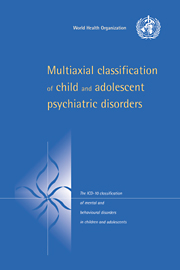 Multiaxial Classification of Child and Adolescent Psychiatric Disorders
Multiaxial Classification of Child and Adolescent Psychiatric Disorders Book contents
- Frontmatter
- Contents
- Introduction
- Axis One (Clinical psychiatric syndromes), page 11 to 98
- (Clinical psychiatric syndromes), page 99 to 176
- Axis Two (Specific disorders of psychological development)
- Axis Three (Intellectual level)
- Axis Four (Medical conditions from ICD-10 often associated with mental and behavioural disorders)
- Axis Five (Associated abnormal psychosocial situations)
- Axis Six (Global assessment of psychosocial disability)
- Acknowledgements
- Index
Introduction
Published online by Cambridge University Press: 05 November 2011
- Frontmatter
- Contents
- Introduction
- Axis One (Clinical psychiatric syndromes), page 11 to 98
- (Clinical psychiatric syndromes), page 99 to 176
- Axis Two (Specific disorders of psychological development)
- Axis Three (Intellectual level)
- Axis Four (Medical conditions from ICD-10 often associated with mental and behavioural disorders)
- Axis Five (Associated abnormal psychosocial situations)
- Axis Six (Global assessment of psychosocial disability)
- Acknowledgements
- Index
Summary
by Professor Sir Michael Rutter
Some 25 years ago, a World Health Organization seminar produced findings that argued for a multiaxial approach to the classification of child psychiatric disorder (1). At that time three axes were proposed: clinical psychiatric syndromes, level of intellectual function and associated or etiological factors (physical or environmental). Subsequently, the suggestions included dividing this third axis into its two parts. In 1975, WHO published a report of trials of these four axes, the first three of which were taken from the Eighth Edition of the International Classification of Diseases ICD-8 (2). These trials indicated the increased reliability associated with the use of the axes. Later in 1975 a multiaxial schema was introduced in the United Kingdom adding yet one further axis for specific developmental disorders, which had previously been included with ‘biological factors’. This schema was based on the newly introduced ICD-9, with a relatively simple list of associated psychosocial situations. Subsequent studies indicated that the reliability of the psychosocial axis was unacceptably low, and with the prospects that a new edition of the ICD would be appearing in the 1990s, a working group was set up to redraft the psychosocial axis, following the same principles used for the psychiatric disorders in ICD-10. This means that this axis includes a much more detailed specification of the criteria to be used for coding each of the separately identified psychosocial stressors.
This book, then, provides a classification of child and adolescent psychiatric disorders that uses the tenth revision of the International Classification of Diseases (ICD-10), but which places it in a multiaxial framework.
- Type
- Chapter
- Information
- Multiaxial Classification of Child and Adolescent Psychiatric DisordersThe ICD-10 Classification of Mental and Behavioural Disorders in Children and Adolescents, pp. 1 - 10Publisher: Cambridge University PressPrint publication year: 1996
- 1
- Cited by


